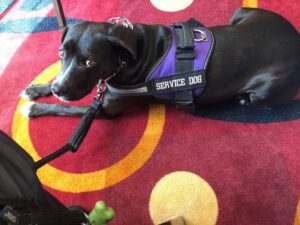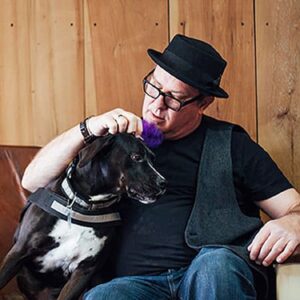
Doggone Helpful: A Look at Service Dogs
By Kim Lew
Not Just Any Dog
When is a dog not a dog? When it’s medical equipment!
Wait…what? How can a dog be medical equipment?
By being a service dog.
Huh?
Service dogs are trained dogs to help with medical conditions. That makes them medical equipment. They are working dogs. The most familiar ones are guide dogs for blind people. But there are also dogs for deaf people, people with physical limitations, autism, epilepsy, diabetes, allergies, and psychiatric conditions. The official definition of a service dog, according to the Americans with Disabilities Act (ADA), is “a dog that is individually trained to do work or perform tasks for a person with a disability.”
I’m autistic and struggle with depression and anxiety. Because of this, I have wanted a service dog for years. To learn more about how to get one if you are autistic or have a mental illness, how service dogs are trained, and how they can assist people, I interviewed J.R. Reed, an autistic advocate and journalist who has had a service dog for five years. Here is what I learned.

J.R.’s service dog Tye
How do you get a service dog?
First, you call an agency that provides them. You can just Google and find different agencies to contact. There are many organizations that train and provide dogs, but not all organizations provide dogs to help with autism or psychiatric conditions like anxiety. Each agency has its own application process. You will need to show a medical diagnosis which can be a letter from your doctor. It will also need to recommend that you get a service dog.
The most challenging part is finding an agency that will provide an affordable dog. I have done a lot of research looking for an organization and found that they can cost anywhere from free to $35,000. It is very difficult to get a free service dog. There are not many businesses that provide them for free and the wait lists are long. Also, many of these organizations have restrictions such as living in a particular region or having a particular condition.
Next, agencies want to be sure the right dog is matched to you. The trainers will require a lot of information. They will need to know what types of issues you have, what tasks you would like the dog to do, and what your daily routine is like. Do you go out a lot or stay home mostly? Where do you typically go? Do you have other pets at home? Do you travel? Where do you work? You may have to wait until the best dog for you is available.
What kind of dog will I get? A Labrador?
Actually, all kinds of dogs can be service dogs from Chihuahuas to Great Danes. It all depends on what the dog will be doing. A Chihuahua could be a great hearing dog, while a Great Dog would be perfect for helping an adult with mobility issues. But, yes, Labradors are the most common type of service dog.
What is involved in training the dog?
Dogs start off by receiving basic obedience training. After that, they receive specific training according to what your life is like and what limitations you have that will be mitigated by the dog. This takes time. Next, dogs need to have public access training to desensitize them to a variety of environments.
After a dog has been trained in the specific tasks that you need done and has had public access training, it is time for you to be trained with your dog. The amount of time this takes will vary from agency to agency. It could be a weekend or longer. Reed spent a weekend training and because he lived nearby, he was able to commute to the agency. Often you will be working one on one with the trainer to make sure everybody is compatible, and you know how to work with the dog.
So, what can your dog do?

J.R. with Tye
I wanted to know what tasks Reed’s dog, Tye, can do. I learned that in addition to autism, Reed has social anxiety and sometimes seizures. Tye can hear his heartbeat and pulse up to 100 feet away. Anytime Reed’s anxiety spikes and his heartbeat or pulse rate goes up, Tye will go to him, put his front paws up on him, and be there. Then, to calm himself, Reed can pet his dog or just be with him. Tye can also sense when Reed is going to have a seizure. Reed hasn’t had one in a long time, but if it happens, Tye will lie on him so that he doesn’t roll around and hurt himself.
Moreover, when Reed has a panic attack in a store, Tye is trained to pull him away from the scene or out to the parking lot, if necessary. I wondered if Reed knows what is going on when Tye starts pulling him. Reed says he picks up on what Tye is doing. He knows he is panicking so he runs right along behind Tye.
To ease Reed’s social anxiety, his dog keeps a safe distance “bubble” around him. In lines, like at the grocery store, Tye stands about three feet behind Reed to establish a barrier between Reed and the person behind him. If they don’t have a shopping cart, the person in front of them can start backing up and crowding into Reed. That’s when Tye springs into action to block the offender.
Is a service dog always well behaved?
To my surprise, I learned that Tye has two distinct personalities. There is his “vest on” personality and his “vest off” personality. With his vest on, Tye, is the quintessential service dog…perfectly behaved, walking right beside Reed, and not pulling on the leash. However, once the vest is off, he’s jumping and running all around the house.
Can you play with a service dog?
Yes, you can. Tye, for instance, loves playing with other dogs and dog parks. Consequently, Reed will often take him there. But forget playing fetch. Tye refuses and insists that Reed get the ball himself.
Is it expensive taking care of a service dog?
That is going to depend on the dog. Tye is a short haired dog. So, he doesn’t need all the grooming that other breeds do. Usually, a bath twice a month at home works fine. If you can’t bathe your dog at home, he will have to have it done at a groomer’s. Other chores for a groomer are the nail trimming and any fur cutting. Dogs also need treats and chew toys. Reed likes to give Tye goat horns to chew on. This is a sustainable chew toy since goats shed their horns. An occasional bone from the butcher is another inexpensive treat Tye enjoys. Of course, a dog needs its vaccinations. Moreover, if she gets sick or has an injury, the vet bill could be high. Other than that, food is the only real expense.
What do you need to keep in mind if you’re thinking of getting a service dog?
What does Reed want people to know about having a service dog? He told me, “I would say that it’s a big commitment. It’s owning a pet plus some.” He also recommends thinking about your lifestyle and whether having a dog with you a lot of the time will fit into that lifestyle. Naturally autistic people aren’t especially social, so going out all the time to fancy dinners or parties isn’t something they really have to think about much. This means having a dog always with you for them isn’t the encumbrance it may be for some people.
Reed’s final words
Reed’s final words on owning a service dog are overwhelmingly positive. He says about Tye that “he’s literally become my best friend and I count on him, and I rely on him.”

Kim Lew is an adult autism and mental health self-advocate. She grew up in Silicon Valley when it was still the Valley of Heart’s Delight. She graduated from Smith College with a degree in Mathematics. Kim was diagnosed in her 40s with Aspergers. Although she has struggled with Major Depression since her early teens, she wasn’t diagnosed until she was in her 30s. She is an active Special Olympic athlete and as a Global Messenger she often MCs events for them. Kim currently teaches second-graders in an after school program.




